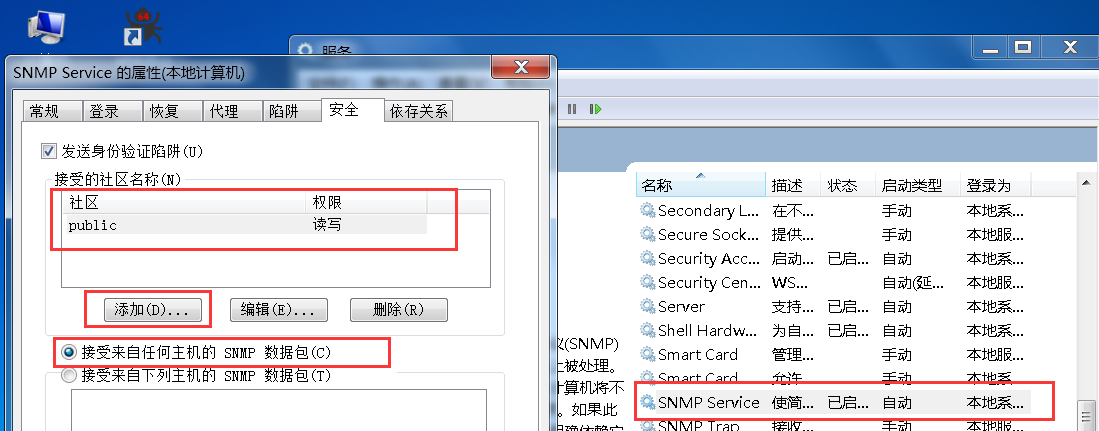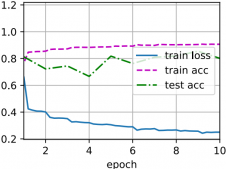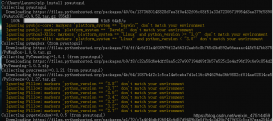PySNMP 是一个纯粹用Python实现的SNMP,用PySNMP的最抽象的API为One-line Applications,其中有两类API:同步的和非同步的,都在模块pysnmp.entity.rfc3413.oneliner.cmdgen 中实现,如下是Get方式与Walk方式的基本实现.
首先需要在系统中安装SNMP客户端,对于Linux平台来说只需要执行如下配置过程即可.
|
1
2
3
4
5
6
7
8
9
10
11
12
13
14
|
[root@localhost ~]# yum install -y net-snmp[root@localhost ~]# cat /etc/snmp/snmpd.conf |grep -vE "^#|^$"com2sec notConfigUser default publicgroup notConfigGroup v1 notConfigUsergroup notConfigGroup v2c notConfigUserview systemview included .1view systemview included .1access notConfigGroup "" any noauth exact systemview none none[root@localhost ~]# systemctl restart snmpd[root@localhost ~]# systemctl enable snmpd |
如果是Windows系统则需要在客户机服务列表,开启SNMP支持,并设置好一个团体名称,如下图。

当我们配置好客户端后,服务端就客户获取数据了,我们以一个OID序号为例,我们查询特定序号对应的名称,然后将其记录下来,例如下面这样。
C:\Users\admin> snmpwalk -v 2c -c public 192.168.1.101 .1.3.6.1.2.1.25.2.2
HOST-RESOURCES-MIB::hrMemorySize.0 = INTEGER: 2096632 KBytes
首先我们不使用PySNMP模块直接开线程调用看看,该代码如下所示.
|
1
2
3
4
5
6
7
8
9
10
11
12
13
14
15
16
17
18
19
20
21
22
23
24
25
26
27
28
29
30
31
32
33
34
35
36
37
38
39
40
41
42
43
44
45
46
47
48
49
50
51
52
53
54
55
56
57
58
59
60
61
62
63
64
65
66
67
68
69
70
71
72
73
74
75
76
77
78
79
|
import os,re,time# 通过SNMP收集主机CPU利用率: 通过SNMP协议,收集目标主机的CPU利用率(百分比),并返回JSON字符串.def Get_CPU_Info(addr): try: Head = ["HostName","CoreLoad","CpuUser","CpuSystem","CpuIdle"] CPU = [] ret = os.popen("snmpwalk -v 2c -c nmap " + addr + " .1.3.6.1.2.1.1.5") CPU.append(ret.read().split(":")[3].strip()) ret = os.popen("snmpwalk -v 2c -c nmap " + addr + " .1.3.6.1.2.1.25.3.3.1.2") CPU.append(ret.read().split(":")[3].strip()) for i in [9,10,11]: ret = os.popen("snmpwalk -v 2c -c nmap " + addr + " 1.3.6.1.4.1.2021.11.{}.0".format(i)) ret = ret.read() Info = ret.split(":")[3].strip() CPU.append(Info) return dict(zip(Head,CPU)) except Exception: return 0# 通过SNMP获取系统CPU负载信息: 分别获取到系统的1,5,15分钟的负载信息,并返回JSON格式.def Get_Load_Info(addr): try: Head = ["HostName","Load1","Load5","Load15"] SysLoad = [] ret = os.popen("snmpwalk -v 2c -c nmap " + addr + " .1.3.6.1.2.1.1.5") SysLoad.append(ret.read().split(":")[3].strip()) ret = os.popen("snmpwalk -v 2c -c nmap " + addr + " .1.3.6.1.4.1.2021.10.1.3") load = list(re.sub(".*STRING: ", "", ret.read()).split("\n")) SysLoad.append(load[0]) SysLoad.append(load[1]) SysLoad.append(load[2]) return dict(zip(Head,SysLoad)) except Exception: return 0# 通过SNMP获取系统内存占用: 内存利用率,获取到之后,将其转化为字典格式保存。def Get_Mem_Info(addr): try: Head = ["HostName","memTotalSwap","memAvailSwap","memTotalReal","memTotalFree"] SysMem = [] ret = os.popen("snmpwalk -v 2c -c nmap " + addr + " .1.3.6.1.2.1.1.5") SysMem.append(ret.read().split(":")[3].strip()) ret = os.popen("snmpwalk -v 2c -c nmap " + addr + " .1.3.6.1.4.1.2021.4") mem = ret.read().split("\n") for i in [2,3,4,6]: SysMem.append(re.sub(".*INTEGER: ","",mem[i]).split(" ")[0]) return dict(zip(Head,SysMem)) except Exception: return 0# 通过SNMP获取系统磁盘数据: 这个案例并不完整,我只写了一点,后面有个问题一直没有解决.def Get_Disk_Info(addr): try: dic = {} list = [] ret = os.popen("snmpwalk -v 2c -c nmap " + addr + " HOST-RESOURCES-MIB::hrStorageDescr") DiskName = ret.read().split("\n") ret =os.popen("snmpwalk -v 2c -c nmap " + addr + " HOST-RESOURCES-MIB::hrStorageUsed") DiskUsed = ret.read().split("\n") ret = os.popen("snmpwalk -v 2c -c nmap " + addr + " HOST-RESOURCES-MIB::hrStorageSize") DiskSize = ret.read().split("\n") for i in range(1,len(DiskName) - 7): dic["Name"]= DiskName[i + 5].split(":")[3] dic["Used"]= DiskUsed[i + 5].split(":")[3] dic["Size"]= DiskSize[i + 5].split(":")[3] list.append(dic) return list except Exception: return 0if __name__ == '__main__': for i in range(100): dic = Get_CPU_Info("192.168.1.20") print(dic) time.sleep(1) |
我们使用pysnmp模块来做,安装pysnmp很简单,执行命令pip install pysnmp 即可,安装后使用以下代码执行即可获取到目标数据,获取方式分为两种一种为Get另一种为Walk.
|
1
2
3
4
5
6
7
8
9
10
11
12
13
14
15
16
17
18
19
20
21
22
23
24
25
26
27
28
29
30
31
32
33
34
35
36
37
38
39
40
41
42
43
44
45
46
47
48
49
50
51
52
53
54
55
56
57
58
59
60
61
|
from pysnmp.hlapi import *import os,sysclass NetSNMP(): def __init__(self,address,region): self.region = region self.address = address # 获取指定数据的方法 def GetNumber(self,oid,sub_oid,sub_id): iterator = getCmd(SnmpEngine(), CommunityData(self.region), UdpTransportTarget((self.address, 161)), ContextData(), ObjectType(ObjectIdentity(oid, sub_oid, sub_id))) errorIndication, errorStatus, errorIndex, varBinds = next(iterator) if errorIndication: return False else: if errorStatus: return False else: for varBind in varBinds: return [x.prettyPrint() for x in varBind] # 使用Walk拉取数据 def WalkNumber(self, oid): res = [] for (errorIndication, errorStatus, errorIndex, varBinds) in nextCmd(SnmpEngine(), CommunityData(self.region),UdpTransportTarget((self.address, 161)),ContextData(), ObjectType(ObjectIdentity(oid)).addMibSource( './site-packages/pysnmp/smi/mibs','pysnmp_mibs'),lexicographicMode=False): if errorIndication: print(errorIndication, file=sys.stderr) break elif errorStatus: print('%s at %s' % (errorStatus.prettyPrint(), errorIndex and varBinds[int(errorIndex) - 1][0] or '?'), file=sys.stderr) break else: for varBind in varBinds: res.append(str(varBind)) return resif __name__ == "__main__": # 初始化 ptr = NetSNMP("192.168.81.130","public") # 使用GET方式获取OID数据 ret = ptr.GetNumber("HOST-RESOURCES-MIB","hrMemorySize",0) print("类型: {} --> 返回结果: {} --> 解析: {}".format(type(ret),ret,ret[1])) # 使用Walk方式获取OID数据 ret = ptr.WalkNumber(".1.3.6.1.2.1.2.2.1.6") for each in ret: mac = each.split("=")[1] if len(mac) > 1: print("网卡接口: {}".format(mac)) |
以上就是Python封装SNMP调用接口的示例代码的详细内容,更多关于Python SNMP调用接口的资料请关注服务器之家其它相关文章!
原文链接:https://www.cnblogs.com/LyShark/p/16512846.html












